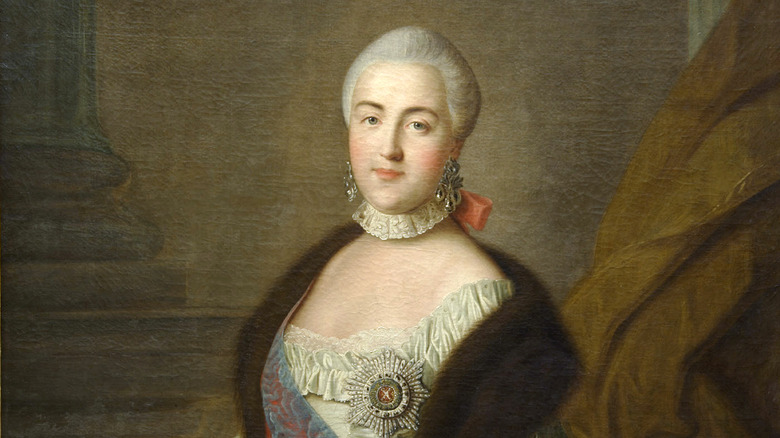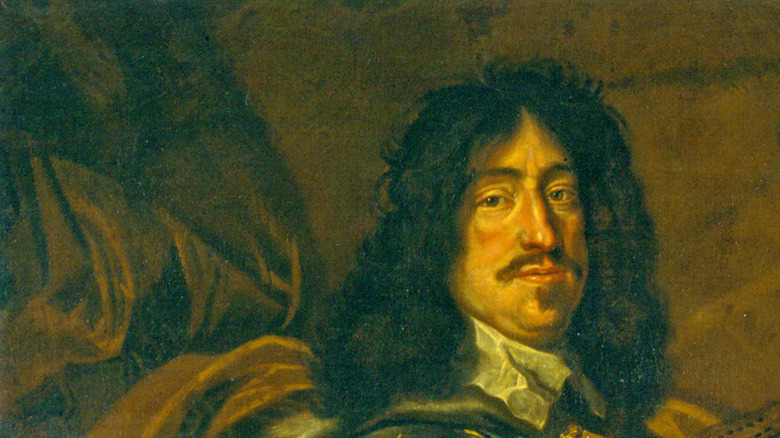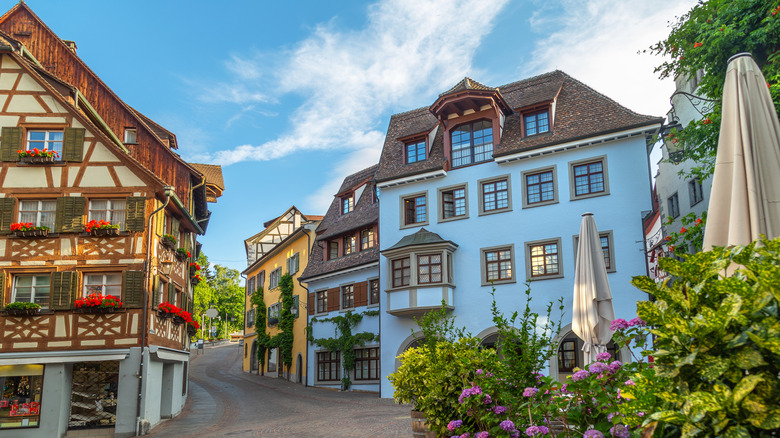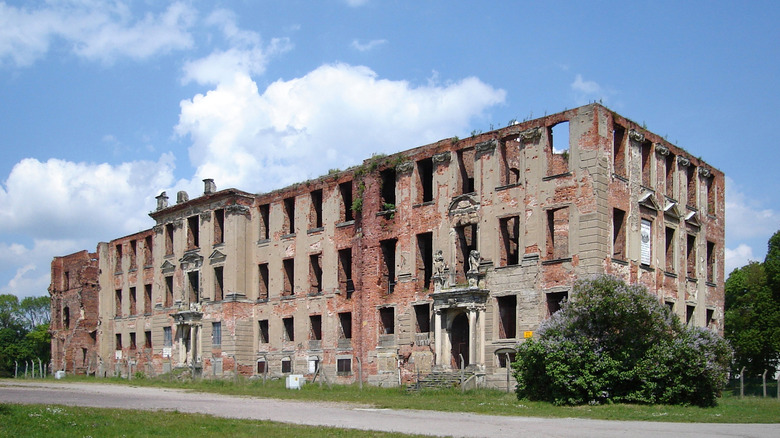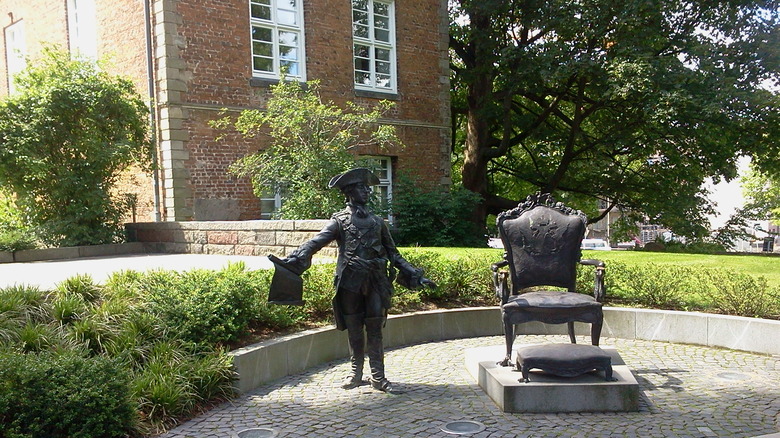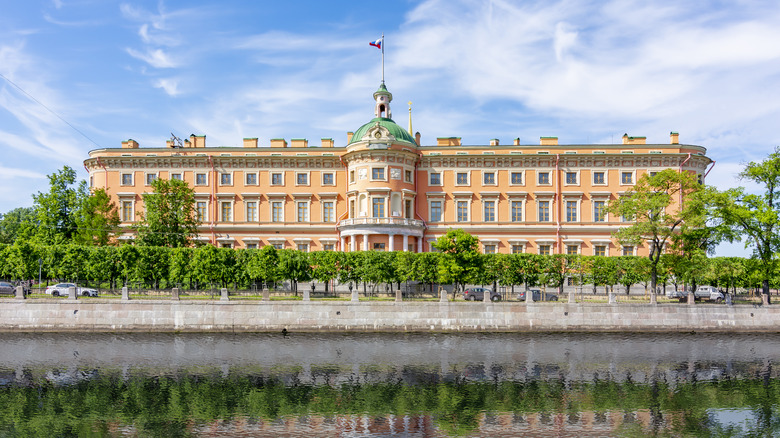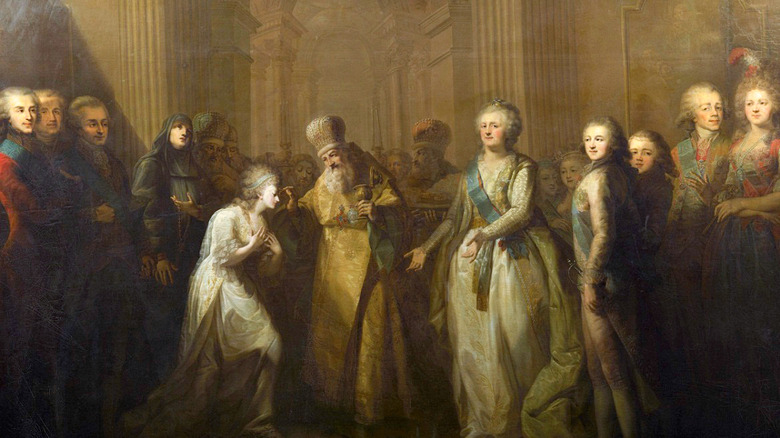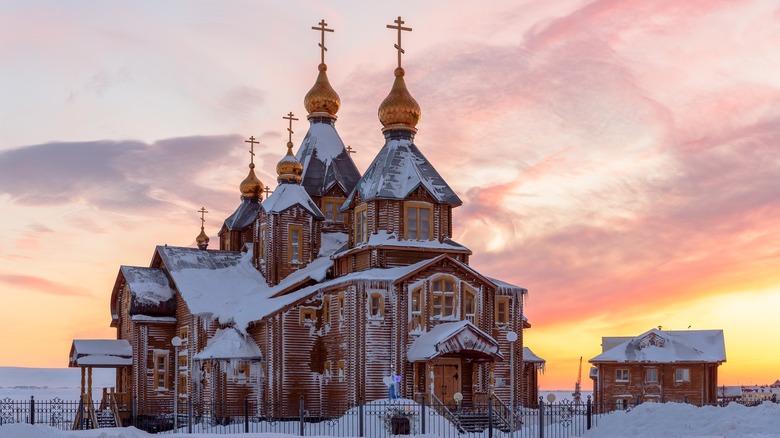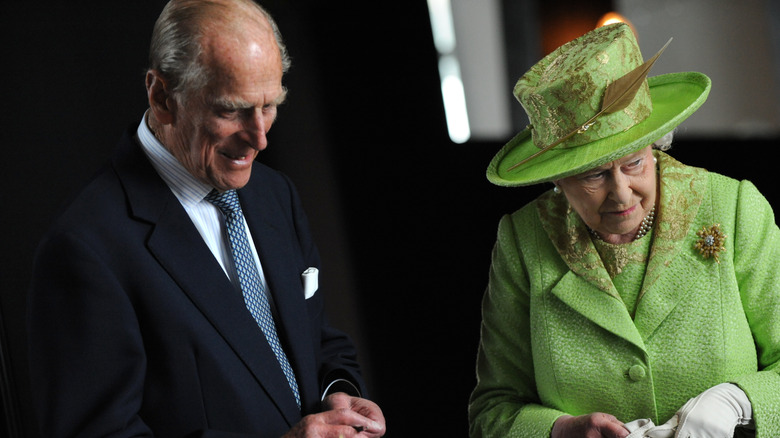Catherine The Great's Family Tree Explained
Catherine the Great was one of Russia's greatest leaders — even though she actually wasn't Russian by birth. Catherine was, in fact, German, first being named Sophie Freiderike Auguste (her name has a few variations) and comes from a long line of fierce princesses and queens (via Britannica). Her father and grandfather were also both German princes.
Her mother Johanna's connections to the dukes of Holstein helped her become engaged to the heir to the Russian throne, Peter III, who was born in Holstein, though their marriage was no picnic. Catherine and Peter's son Paul wasn't favored by his mother either, though Paul's son Alexander was. Ultimately, Catherine is an ancestor of the rest of the Romanov dynasty, which ruled Russia until the Russian Revolution.
Due to said Revolution in 1917, many members of the Romanov family fled Russia for other countries, and as such Catherine has descendants all over the world. Prince Philip, Duke of Edinburgh, was one of her descendants. Other former royals — and not-so-former royals, such as the rest of the British royal family though Philip — can count themselves among her descendants. With ancestors who mainly stayed in Northern Europe and southwest Germany, it's impressive that Catherine's reach has spread so far through her family members. Catherine the Great's family tree is large, varied, and still growing — let's explore it.
Ancestors: Kings of Denmark and a Queen of Sweden
Due to Catherine's mother Johanna's position as a daughter of Holstein, many of her ancestors come from the same area, namely Denmark and Sweden; on her father's side, she's connected to the Anhalt region of Germany. Catherine was very closely connected to royalty from those areas.
Princess Frederica Amalia of Denmark was Catherine's great-grandmother; King Frederick III of Denmark and Norway was therefore Catherine's great-great grandfather (via Cristoph Heinrich von Ammon's Genealogie). In turn, Frederica's sister Ulrika Eleonora was the Queen of Sweden, though she was known as Ulrikke in Denmark, writes Rosenborg Castle; she was married to Charles XI in 1680. Though Ulrika had no political influence in her new country and thus couldn't make much political change, she threw herself into charity work and artistry instead.
One of Catherine's great-great grandfathers was King Frederick III of Denmark and Norway, who took the position in 1648. Today, according to Britannica, he is mainly known for turning Denmark into an absolute monarchy. Under Frederick's rule, Denmark went to war with Sweden multiple times. With the result of the war, Frederick had absolute power conferred upon him; he proceeded to radically reorganize the government. That said, Frederick was capable of more than just ruling and war; Rosenborg Castle writes that Frederick was very interested in French culture and artistry, science, and theology.
Maternal Grandparents: Duke Christian August of Holstein-Gottorp and Princess Albertina Frederica of Baden-Durlach
Catherine's maternal grandparents were obscure German nobles descended from royalty. Some of their descendants commanded as kings or empresses, in Catherine's case, while others, such as Catherine's brother Friedrich, continued as they always had by serving as rulers of small parts of what is now Germany (via Stadt Jever).
According to Encyclopedia, Albertina of Baden-Durlach (located in what is now southwestern Germany) was married in 1704; her mother Augusta Maria was from the Holstein-Gottorp family, so Albertina in turn married back into the family. She and her husband Christian August had 12 children, one of whom was Johanna Elizabeth, Catherine's enterprising mother. Several children died young, though their son Adolphus Frederick grew up to be the king of Sweden.
Christian August, Catherine's grandfather, was the second son of Christian Albert, who served as the Bishop of Lubeck, writes British Museum. His mother was Frederica Amalia, a princess of Denmark and daughter of Frederick III.
Paternal Grandparents: Johann Ludwig I, Prince of Anhalt-Dornburg, and Christine Eleonore von Zeutsch
Johann Ludwig von Anhalt-Dornburg spent several years abroad, including on a military trip to Hungary, before settling in Dornburg and getting married to Christine Eleonore, who came from a noble Saxon family. Johann Ludwig worked tirelessly to secure his inheritance for his children, according to Johann Putter's 1796 treatise on mismarriages and Johann Moser's 1745 and 1775 works on the subject (via Heraldica).
In 1689, Johann asserted his children's legitimacy in a clause sent to the Emperor. As his male relatives began to die off over the years, the possibility of the Zerbst principality falling to his heirs began to seem probable, though Johann took more precautions in the meantime. For example, according to Putter and Moser, in 1698, he received a decree that declared his many children to be princes and princesses (via Heraldica).
Therefore, Johann's children, including his son Christian August, father of Catherine the Great, were considered dynastic, meaning they could inherit his titles, fiefs, and other property he owned. (Speaking to the specifics of royal inheritance, Johann's marriage was thus the opposite of a morganatic marriage, where a nobleman married a woman of lesser birth and their children could not inherit anything, per Britannica). Therefore, Johann's son Christian August inherited Anhalt-Zerbst.
Parents: Christian August, Prince of Anhalt-Zerbst, and Duchess Johanna Elisabeth of Holstein-Gottorp
Catherine's mother Johanna was related to the dukes of Holstein who assisted in arranging her daughter's advantageous marriage to the heir of the Russian throne, writes Britannica. However, according to Catherine, Johanna did not "bother much about me" (via Encyclopedia). Despite this, Catherine was the only female child of her parents to survive to adulthood.
Johanna's relatives, however, had influenced Empress Elizabeth of Russia to invite the future Catherine (then Sophia) and Johanna to Russia to settle her marriage to the future Peter III, previously named Karl. Johanna, however, hadn't bargained on her own intrigues with Frederick of Prussia getting around. Johanna was thus banished from Russia in 1745 when it became known that Frederick had asked her to intercede on behalf of Prussian interests while at Empress Elizabeth's Russian court, writes Encyclopedia. She and her daughter Catherine never saw each other again.
Catherine's father Christian August, on the other hand, was a fairly obscure German prince. Today, he is mainly known for helping to unite his father's principality of Anhalt-Dornburg with his principality of Anhalt-Zerbst (via European Heraldry). Christian August died two years after Catherine's marriage to Peter III, in 1747, and his position was inherited by his son Friedrich, who was 12 at the time of his death; Johanna served as his regent for the next five years (via Elle).
Siblings: Auguste, Elisabeth, Friedrich, and Wilhelm
Only one of Catherine's siblings survived to adulthood: Friedrich, who was the last ruler of Anhalt-Zerbst. The other three, including Auguste, Elisabeth, and Wilhelm, all died relatively young (via The Famous People). Elisabeth in particular died at the age of 3, writes Elle.
After being expelled from Russia in 1745, Catherine's mother Joanna served as regent for her son Friedrich, who reached his majority in 1752 at the age of 18, writes Elle. After Friedrich's death in 1793, the principality of Anhalt-Zerbst was divided by the other nearby branch principalities (Anhalt-Bernburg, Anhalt-Köthen, and Anhalt-Dessau) and, in essence, ceased to exist, according to Britannica. Friedrich had been married twice but Anhalt-Zerbst became extinct upon his 1793 death (via European Heraldry and Britannica).
Catherine inherited the German city of Jever upon her brother's death, but only held it until her own death three years later, writes European Heraldry. Catherine appointed Friedrich's second wife and widow Friederike Auguste Sophie von Anhalt-Zerbst as the state administrator in 1793, a position Friederike held until 1806, according to Stadt Jever. Ultimately, the overall principality of Anhalt was absorbed into the nation of Germany and became a Land of the German Reich under the 1919 Weimar Constitution, according to Britannica.
Husband: Peter III
Catherine essentially hated Peter on sight, and their marriage, which began in 1745, was a disaster for several decades. Peter had only been named the heir to the Russian throne three years previously, writes Britannica, but he held much more loyalty to Prussia and his own heritage of Holstein than to Russia.
Peter inherited the throne from his aunt Elizabeth in January 1762. He immediately reversed her foreign policy, including backing out of the Seven Years' War. Peter then allied with Prussia, in turn making many Russians angry, since they had just been fighting against the country during the Seven Years' War. Peter then went to war with Denmark, mainly to help out Holstein, the place where he was born (and likely the place he held closest to his heart).
Peter continued to be unpopular in his own country as the year wore on, alienating the Russian Orthodox Church and the Russian imperial guard. His wife Catherine lived on the opposite side of the Winter Palace, which enabled her to plan a coup against him — one which she acted upon in the middle of 1762, writes Russia Beyond. Peter abdicated the day after Catherine was formally declared as Empress, according to Britannica. He was killed in July of 1762 while in the custody of one of Catherine's noble supporters, Grigory Orlov.
Children: Paul I and Anna
Paul I was Catherine's only surviving legitimate child, but they had a strained relationship. Paul's great-aunt Elizabeth (empress of Russia before Peter III) preferred him as an heir, and she took him away from Catherine to raise him as her own. However, even when Catherine became empress, she, too, ignored him, and he ultimately spent much of his time in Gatchina, writes The Famous People. Though he became Tsar, Paul was eventually assassinated after a brief but turbulent rule.
According to The Famous People, Paul ignored his mother's policies and subsequently was against both Britain and France (especially the latter). He introduced several unpopular reforms, both with the army and with his nobles. He attempted to reform the army's uniforms, as he was very fond of pomp and ceremonies. The Infantry Code, which placed more focus on ceremonies, was also disdained by his officers. Ultimately, a group of dissatisfied men in the army banded together to assassinate him in 1801, just five years after he took the throne. His son Alexander I succeeded him, and he ultimately pardoned his attackers.
Catherine's daughter Anna died at the age of 2. It is possible that Anna was actually the daughter of Catherine's lover Stanislaw Poniatowski, though this isn't known for certain, writes History.
Other illegitimate children: Alexei and Elizabeth
Catherine had two possible illegitimate children, both with men other than Peter III. Catherine was well-known for her lovers, and she had favorites even up to her death, writes HIstoryHit.
Count Alexei Bobrinsky was the son of Catherine the Great and Grigory Orlov, one of her lovers and supporters during her coup against Peter III. According to Russia Beyond, Alexei was born during a purposefully-set fire to cover up his birth, since at the time she was still married to Peter III. He was raised with Catherine's valet, Vasiliy Shkurin, and his family. After attending school abroad in Germany with Shkurin's sons, Bobrinsky was brought back to Russia and instructed in the sciences by Ivan Betskoy (via Russia Beyond). He eventually became a military officer, but after Catherine the Great's death, his half-brother Paul summoned him to St. Petersburg and broke the news of his actual parentage. Bobrinsky, known as such for a village Catherine gave him (Bobrikovo), ultimately took up agricultural and other scientific studies, including astronomy.
Elizabeth Temkina was an infant who appeared one day in Grigory Potemkin's household; it is possible she is the daughter of Catherine and her lover Potemkin, but this hasn't been fully proven. Catherine never acknowledged her as she did Bobrinsky, writes InfoPlease.
Grandson: Alexander I
Catherine greatly preferred Alexander over his father, and when Paul was assassinated, she got her wish: Her grandson Alexander succeeded her. Alexander, writes Britannica, was married by his grandmother to Princess Louise of Baden-Durlach at a fairly young age, though the marriage was not a happy one. Regardless, after his father was assassinated in 1801, Alexander became the tsar.
Alexander instituted many reforms, mainly a vast plan for education; for example, he oversaw the opening of three new universities. However, he didn't manage to abolish the burden of serfdom, despite the massive problems it presented. Instead, Alexander turned to foreign policy, which he would spend most of the rest of his reign focusing on. He was ultimately successful in fighting against Napoleon Bonaparte's army in 1812 (via Britannica). On the diplomatic front, Alexander felt that like his grandmother Catherine the Great, he was called to mediate across Europe. He ultimately was successful in this, intervening on France's behalf twice during the creation of various peace treaties.
In his later years, Alexander became religious, and he saw rebellion everywhere. After escorting his wife to Taganrog for her health, he toured Crimea to inspect it. On his way back, Alexander contracted either malaria or pneumonia and ultimately died of illness in 1825. Per Britannica, he was succeeded by one of his brothers, who became Nicholas I that same year.
The Romanovs
The Romanov dynasty continued to rule Russia until the Russian Revolution in 1917. The succession was consistently either between brothers or between fathers and sons (via The Museum of Russian Art), so Catherine is an ancestor of the rest of the direct Romanov line. Several members of the Romanov family went into exile during the Revolution, including Nicholas II's mother, two of his sisters (Xenia and Olga), and their husbands. The headship today has been claimed by Grand Duchess Maria Vladimirovna of Russia (great-great-granddaughter of Alexander II). However, Prince Andrew Romanov (grand-nephew of Nicholas II through his sister Xenia) inherited his male relative's claim to the throne before his own death in November 2021 (via Marin Independent Journal).
Maria and Andrew were the heads of rival branches of the Romanov family tree, who disagree on how to count legitimacy, explains History. The Romanov Family Association, which supported Andrew, believes in claimants from non-dynastic marriages (ie. from ancestors who married outside the dynasty). Meanwhile, Maria and her branch of the family have never been members of the Association, and do not believe that non-dynastic Romanovs have a legitimate claim to the throne.
More recently, George Romanov, Maria's son and a distant descendant of Nicholas II, married his fiancee Rebecca Bettarini in October 2021 in St. Petersburg, writes BBC.
Descendants in other parts of the world
Due to the intermingling of royal houses, as well as the marriages Romanovs who had fled Russia later made, Catherine the Great is an ancestor of many other royals throughout the world. Per History, a handful of British royals — and a former Greek king — can count her among their family, though one name in particular stands out.
According to Town and Country Magazine, Prince Philip, Duke of Edinburgh, could trace his lineage back to her through both of his parents. His maternal grandmother was the sister of Tsarina Alexandra Feodorovna, the wife of Nicholas II. On his father's side, however, he had a more direct link to the Romanovs. Philip was the great-great-grandson of Nicholas I, who in turn was the grandson of Catherine the Great. Philip also gave a blood sample to researchers who used his DNA to conclusively identify Nicholas II, his family, and their entourage after they had all been buried in an unmarked grave, writes Woman and Home. If indirectly, Catherine the Great's legacy assisted in discovering her ancestors' bodies so they could finally be properly put to rest.
Overall, Catherine the Great rose from obscurity in Germany to become something amazing (via Britannica). Her descendants continued her great era as best they could, despite the changing times, with her grandson Alexander likely being the most successful (via Britannica). Ultimately, Catherine brought forth a golden age for Russia that has never been recreated.
